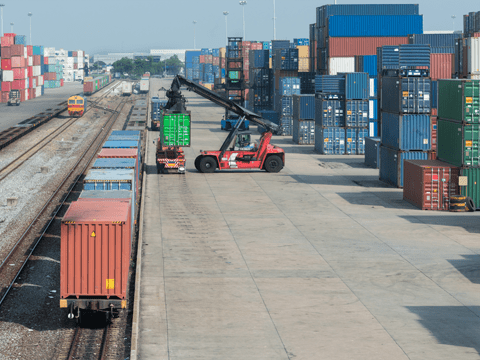The road freight transport should decrease to less than 75% in the European Union, increasing the share of rail and inland waterway transport, according to a new plan by the European Commission.
The European Commission presented its «Sustainable and Smart Mobility Strategy» on Thursday, along with an action plan consisting of 82 initiatives that will guide its work over the next four years.
Likewise, the European Green Deal requires that a substantial part of 75% of inland freight transport currently carried by road be moved to rail and inland waterways.
Short sea shipping and efficient zero-emission vehicles can also contribute to making freight transport greener in Europe.
«Urgent action must therefore be taken given the limited progress made to date,» the European Commission said.
As an example, the modal share of rail in land freight transport decreased to 17.9% in 2018 from 18.3% in 2011.
Freight transport
Under the plan, incentive mechanisms should be based on impartial performance monitoring, in accordance with a European framework for measuring transport and logistics emissions.
Multimodal logistics must be part of this transformation, inside and outside of urban areas.
At the same time, the growth of e-commerce has significantly changed consumption patterns, but the external costs of millions of deliveries must be taken into account, including the reduction of empty and unnecessary routes.
Therefore, sustainable urban mobility planning must also include the dimension of freight transport through urban logistics plans.
The European Commission adds that these plans will accelerate the deployment of zero-emission solutions already available, including cargo bikes, automated deliveries and drones (drones) and better use of inland waterways to cities.
The shortage of transshipment infrastructure, and inland multimodal terminals in particular, is pronounced in some parts of Europe and should be given top priority.
Furthermore, missing links in the multimodal infrastructure should be closed and the transportation system should function more efficiently overall with better transshipment technologies.
Priorities
The EU needs multimodal data exchange, as well as intelligent traffic management systems in all modes.
Ultimately, all modes of freight transport must be linked via multimodal terminals and the Commission will take initiatives so that EU funding and other policies, including support for Research and Development, are better geared towards addressing these. problems, fully respecting the Union’s international obligations.
Railway transport
The revision of the state aid rules for railways, which already provide a flexible framework for publicly financing multimodality, will further contribute to that goal.
In recent years, innovative companies have shown that rail freight can operate reliably and be attractive to customers.
However, many national rules and technical barriers still hamper performance. Rail freight transport needs a major boost through increased capacity, greater cross-border coordination and cooperation between rail infrastructure managers, better overall management of the rail network and the deployment of new technologies such as digital coupling and automation. .
The Commission will propose the revision of the regulations governing the rail freight corridors and the corridors of the main network of the TEN-T.
The integration of these corridors into the ‘European transport corridors’, focusing on ‘quick wins’ such as train length, loading width and improved operational rules, together with the completion of key missing links and adaptation of the main network to be fully capable of transporting goods, strengthen the infrastructural dimension of our actions to promote intermodal transport.
Finally, the Commission will propose to improve the rules on rail capacity allocation in line with the ongoing project on schedule redesign, to provide additional and flexible rail tracks. The implementation of the European standards on rail noise will help alleviate related concerns.
![]()

